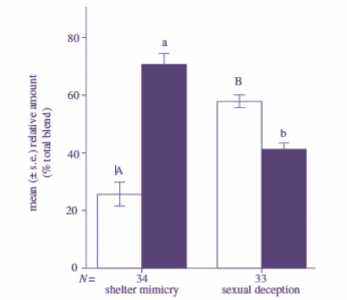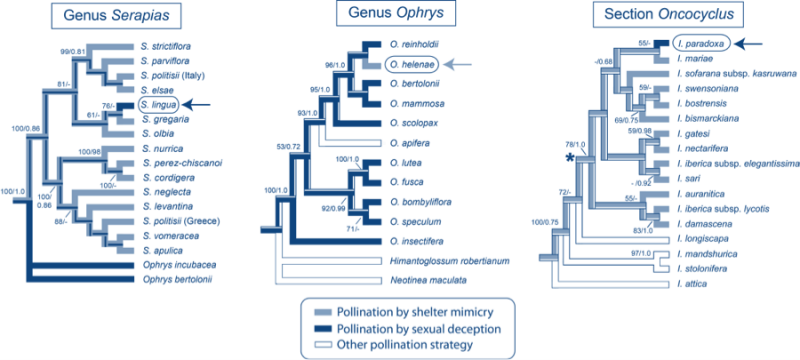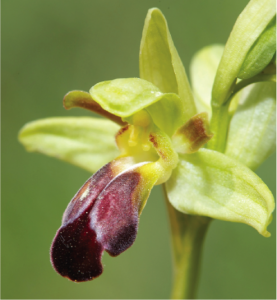Pollination by Sexual Deception
Goals
To test the hypothesis that mimicry of shelters and sexual deception may be evolutionary transitions in some plant groups.
Data
The study included species from two orchid genera (Ophis and Serapias) and Iris. Interactions were observed between plants and bees for evidence of bees seeking shelter in flowers or attempting to copulate with floral organs. Floral scents and spectral analyses were gathered from six flowers, one each representing shelter mimics and sexual deception for the three genera. DNA sequence data was used to develop phylogenetic hypotheses for each genus.

Comparison of n-alkenes (white bars) and n-alkanes (purple bars) in pollination syndromes
Analyses
Statistical tests were used to compare the relative amounts of two classes of compound, n-alkenes and n-alkanes, between night-sheltering and sexually deceptive species. The most likely trees were determined using likelihood and Bayesian analyses and the history of pollination syndromes were estimated using a Markov k-state model.

Important Findings
This is the first report of sexual deception through pseudocopulation in two genera, occurring in Serapias lingua and Iris paradoxa, and is the first report of pseudocopulation in Iridaceae. This pollination strategy is associated with Ophrys in Orchidaceae and is only known from a handful of other species. Ancestral reconstructions showed that in Serapias and Iris sexual deception represents a shift from shelter mimicry. There is a shift from sexual deception in Ophrys to shelter mimicry in O. helenae, demonstrating that extreme specialization in pollination strategy is not an evolutionary dead-end but instead reversals to a more general condition are possible. We propose that the relatively high amounts of n-alkenes and n-alkanes present in these study groups acted as a pre-adaptation for attraction of male bees. These compounds are present in plant and insect cuticular waxes where they have a role in reducing water loss but are also known to act as female sex pheromones in several groups of bees. We suggest that changes in floral morphology, coloration, and relative amounts of n-alkenes and n-alkanes contributed to the shift from shelter mimicry to sexual deception.

Serapias lingua

Iris paradoxa
Conclusions
Shifts between shelter mimicry and sexual selection in these plants are likely to occur due to relatively minor changes in floral scents and flower morphology and coloration.
Citation
Refer to Vereecken, N. J. C. A. Wilson, S. Hötling, S. Schulz, S. A. Banketov and P. Mardulyn. 2012. Preadaptations and the evolution of pollination by sexual deception: Cope’s rule of specialization revisited. Proceedings of the Royal Society B 279: 4786–4794.
